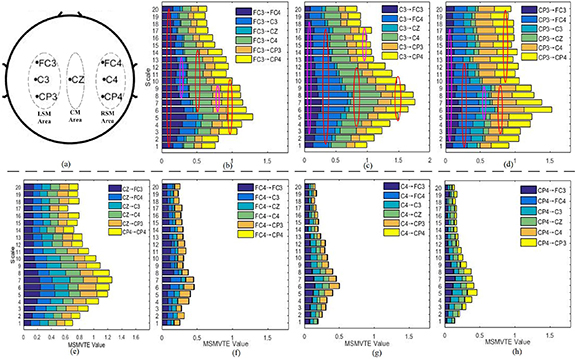


Yuanyuan Zhang, Xiaoling Chen, Xiaohui Pang, Shengcui Cheng, Xiaoli Li and Ping Xie*
Objective. Complex biological systems consist of multi-level mechanism in terms of within- and cross-subsystems correlations, and they are primarily manifested in terms of connectivity, multiscale properties, and nonlinearity. Existing studies have each only explored one aspect of the functional corticocortical coupling (FCCC), which has some limitations in portraying the complexity of multivariable systems. The present study investigated the direct interactions of brain networks at multiple time scales.Approach. We extended the multivariate transfer entropy (MuTE) method and proposed a novel method, named multiscale multivariate transfer entropy (MSMVTE), to explore the direct interactions of brain networks across multiple time scale. To verify this aim, we introduced three simulation models and compared them with multiscale transfer entropy (MSTE) and MuTE methods. We then applied MSMVTE method to analyze FCCC during a unilateral right-hand steady-state force task.Main results. Simulation results showed that the MSMVTE method, compared with MSTE and MuTE methods, better detected direct interactions and avoid the spurious effects of indirect relationships. Further analysis of experimental data showed that the connectivity from left premotor/sensorimotor cortex to right premotor/sensorimotor cortex was significantly higher than that of opposite directionality. Furthermore, the connectivities from central motor areas to both sides of premotor/sensorimotor areas were higher than those of opposite directionalities. Additionally, the maximum coupling strength was found to occur at a specific scale (3-10).Significance. Simulation results confirmed the effectiveness of the MSMVTE method to describe direct relationships and multiscale characteristics in complex systems. The enhancement of FCCC reflects the interaction of more extended activation in cortical motor regions. Additionally, the neurodynamic process of brain depends not only on emergent behavior at small scales, but also on the constraining effects of the activity at large scales. Taken together, our findings provide a basis for better understanding dynamics in brain networks.
目的。复杂的生物系统由多层次机制组成,包括系统内和跨子系统的相关性,主要表现为连通性、多尺度特性和非线性。现有的研究都只探讨了皮质功能耦合(FCCC)的一个方面,这在刻画多变量系统的复杂性方面有一定的局限性。本研究调查了大脑网络在多个时间尺度上的直接相互作用。我们扩展了多元转移熵(MuTE)方法,并提出了一种名为多尺度多元转移熵(MSMVTE)的新方法,以探索大脑网络在多个时间尺度上的直接相互作用。为了验证这一目标,我们引入了三种模拟模型,并将它们与多尺度转移熵(MSTE)和MuTE方法进行了比较。然后,我们应用 MSMVTE 方法分析了单侧右侧稳态力任务中的 FCCC。模拟结果表明,与 MSTE 和 MuTE 方法相比,MSMVTE 方法能更好地检测直接相互作用,避免间接关系的虚假影响。对实验数据的进一步分析表明,从左运动前/感觉运动皮层到右运动前/感觉运动皮层的连通性明显高于相反方向的连通性。此外,从中央运动区到两侧运动前区/感觉运动区的连通性也高于相反方向的连通性。此外,研究还发现,最大耦合强度出现在特定范围(3-10)。模拟结果证实了 MSMVTE 方法在描述复杂系统的直接关系和多尺度特征方面的有效性。FCCC 的增强反映了大脑皮层运动区域更广泛激活的相互作用。此外,大脑的神经动力学过程不仅取决于小尺度的突发行为,还取决于大尺度活动的约束效应。综上所述,我们的发现为更好地理解大脑网络的动态变化提供了基础。